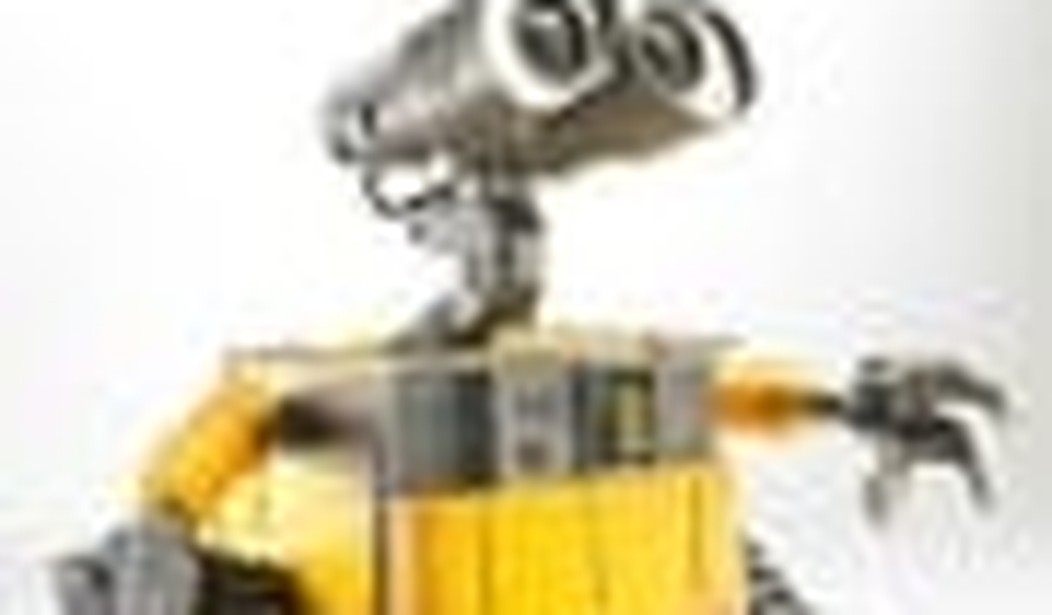WALL-E is a cornucopia of filth, dust, rust and roaches, but if I wanted all of that I’d go back to my first New York City apartment. Compared to other kid flicks (or adult flicks, or even Ingmar Bergman flicks), this is one Gloom-E piece of work.
WALL-E is the last (sort of) living creature on earth, a bedraggled and lonesome robot who spends his days in a befouled metropolis that makes the one in I Am Legend look like Oz. The earth has been made uninhabitable by junk and pollution, its skies as brown as a bad day in Beijing, but at least apocalypse provides a good living: the job for which WALL-E is programmed is to gather up rubbish, compact it into cubes, and stack those as high as skyscrapers. As the trashopolis rises around him, he spends his spare time arranging his favorite salvaged items (a Rubik’s Cube, a spork) and watching an old videotape (jury-rigged to play through an iPod) of Hello, Dolly. WALL-E’s living quarters amount to a tool shed of despair, although by the standards of New York City circa 2008, it’s merely a fixer-upper with lots of potential.
A more advanced flying probe-bot sent to Earth for reasons unknown has feminine curves and lovely blue eyes that leave WALL-E smitten, though except for her habit of laser-zapping any suspicious object she could be one of those white bullet-shaped trash canisters you’d see at a snack bar.
When she and WALL-E start to beep sweet nothings at each other, she has a higher-pitched tone than he does and says her name is Eva, so WALL-E is confirmed to be a heterobot. The two of them wind up at a space station that houses the remnants of the human race. At this point the film, previously dingy and dark, goes matte black.
The earthlings — or maybe Americans, as none of them have any other kind of accent — are brain-dead blobs perpetually stuffed to the gills with entertainment. They never leave their spotless flying barcaloungers — and never could, since their bones have shrunk to useless twigs inside their Shrek-like masses. They float through their troglodyte lives as unquestioning subjects of the master corporation (the same one that ruined the Earth) that houses them, distracts them and feeds them. All foods are made to be sucked down like milkshakes for maximum convenience.
It’s hard to see how a Disney-certified happy ending can result from this, and the answer is it really can’t. This is perhaps the most cynical and darkest big-budget Disney film ever, and an artistic gamble on the scale of Fantasia, which initially flopped despite critical acclaim. Pixar is now acting like Disney’s senior partner. Perhaps never before has any corporation spent so much money on insulting its customers — WALL-E is expected to be the year’s most heavily promoted film.
The meatball humans in WALL-E are like customers passively being served up a fake existence at the Magic Kingdom (which readily provides wheelchairs for not merely the afflicted but also the obese and the simply lazy), snorfling up the latest wows in an entirely artificial setting where every beverage and hotel room brings profits to the same corporation. And Disney paved over a few thousand acres of Florida wetlands to build Walt Disney World in the first place.
How paying customers will react to being told they’re porky slobs, or are headed in that direction (WALL-E is set 800 years in the future) will depend on how closely the people in the audience ignore the people on screen and concentrate on WALL-E and Eva.
The robots are cute but limited by a lack of dialogue, and their storylines essentially consist of a lot of Buster Keaton-style slapstick as a variety of evil machines try to steal from them a small plant from Earth that they brought with them as evidence that the planet is inhabitable again. That poses a threat to the corporation that is generating so much profit from its captive audience on the space station.
WALL-E isn’t much of a character, though, and the conflicts in the film are not only slow to develop but have hazily-defined stakes. Regardless of what happens with the plant, regardless of whether a HAL 9000-like computer named Otto and the corporation he represents succeed in convincing the puppet captain of the space ship that there is no reason to return to Earth, the planet is essentially beyond hope.
The repeated allusions to 2001 (including some musical cues which are now trite) reminded me of how much more human Stanley Kubrick’s film was; Dave Bowman, unlike the space station captain in WALL-E, was resourceful and dynamic, not a blubbery idiot, and his adventure was leading to a mighty payoff, not a possible trip back to an apoca-landfill. What will the humans do to rebuild on Earth if they go back to it anyway? They are about as skilled as crash-test dummies.
Those who go to WALL-E expecting a mechanical E.T. should be prepared instead to inhale the fumes of an almost sulfurous satire.
WALL-E
Directed by Andrew Stanton
Starring: Ben Burtt, Elissa Knight, Jeff Garlin
2.5 stars/ 4
97 minutes/Rated G









Join the conversation as a VIP Member